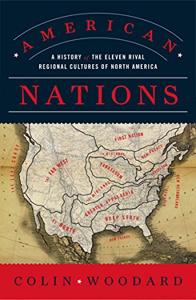
Want to learn the ideas in American Nations better than ever? Read the world’s #1 book summary of American Nations by Colin Woodard here.
Read a brief 1-Page Summary or watch video summaries curated by our expert team. Note: this book guide is not affiliated with or endorsed by the publisher or author, and we always encourage you to purchase and read the full book.
Video Summaries of American Nations
We’ve scoured the Internet for the very best videos on American Nations, from high-quality videos summaries to interviews or commentary by Colin Woodard.
1-Page Summary of American Nations
Overall Summary
Colin Woodard’s book, American Nations: A History of the Eleven Rival Regional Cultures of North America takes a look at regionalism in the United States and how it has shaped our country. He argues that there are 11 distinct regions across North America, each with its own unique history. His book reveals the origins of our fractured continent and gives us new perspective on who we are as Americans today. Even though we’re united as one country, these regions still maintain their distinctive ideals which is evident in Congress and presidential election maps.
Woodard believes there were six revolutions in the American Revolution. Each region had a different reaction and experience during the revolution, but only one of them experienced it as a fight for revolutionary ideals. The Deep South was afraid that if they fought for those ideals, their slaves would revolt against them.
After the Revolutionary War, cultural differences in America were apparent. The North was more Yankee than the South, which had a Deep Southern culture. Meanwhile, Midlanders settled in the middle of the country and imposed their Germanic culture on it. Also, slave-owning Tidewater lost its influence and New Netherland remained coastal. Meanwhile, California became somewhat like northern regions of the United States because Yankees largely settled there while parts of Oregon and Washington also had Appalachian characteristics.
The Civil War was fought between the two main cultures of the mid-19th century, Yankeedom and Deep South. Woodard argues that if the Confederates hadn’t attacked Fort Sumter, there might not have been a war because most other regions were ambivalent about secession.
In the last section, Woodard traces the development of cultural wars in America. The Northern Alliance (Yankee-dom, New Netherland and Left Coast) has been at odds with Dixie’s Deep South and Tidewater as well as Appalachia. El Norte – a region where people of Mexican descent are making a comeback – is also growing stronger. Canada’s First Nations tribes have also seen a resurgence recently. To sustain our country’s future, we need to return to its founding principles that include open debate and compromise
Introduction
The author starts by discussing Glenn Beck speaking at the Lincoln Memorial in 2010. He says that Americans should rediscover their shared values. This is a common idea among intellectuals, including those who were wary of immigration at the turn of the 20th century.
However, Woodard writes that the US has been divided since its founding. People from different parts of Europe who brought their own cultures founded each region in the US. These regions were competitive with each other and thought about leaving the union after they won independence from England during the Revolutionary War. Each region had its own principles, which often contradicted one another and made it difficult to unite at times. By mid-1700s, there were eight distinct regions in the southern and eastern US, which were quite isolated from each other. Nowadays, there are 11 regional nations that bleed over into Canada and Mexico as well as cultural differences between northern states like New York or Massachusetts versus southern states like Georgia or Florida.
A nation is a group of people who share the same culture. Woodard’s book traces the development of these nations, which often conflict with each other. He shows that state and national boundaries on maps cut through some of those cultures.
The author describes the 11 nations in this way: The founders of Yankeedom (the region) wanted to create a religious utopia. This region has always emphasized education, local political control, and community strength. People here have more faith in the government than any other region to make people’s lives better. Stable families settled Yankeedom, which values education and wants to improve society—a secular Puritanism. Yankees have long fought with the Deep South for control over America.






